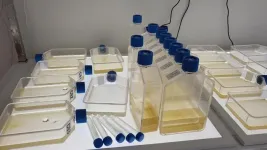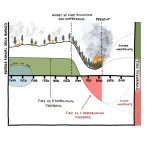(Press-News.org) New research has highlighted microalgae’s capacity as a solution in the fight against climate change, but researchers warn that “smart microalgal bioprospecting” is needed to unlock its full potential.
The study highlights the vast, largely unexplored capacity of microalgae to mitigate CO2 emissions while driving sustainable industry.
“Microalgae have remarkable properties that make them an ideal tool for tackling climate change,” said lead author, PhD candidate Joan Labara Tirado from the University of Technology Sydney (UTS).
The review paper, The need for smart microalgal bioprospecting was recently published in the journal Natural Products and Bioprospecting.
Beyond CO2 sequestration, microalgae offer significant promise as ‘cellular factories’ that can transform captured carbon into valuable products.
“Microalgae grow incredibly fast, absorb CO2 at a much higher rate than terrestrial plants, and don’t compete for arable land, making them a viable option for sustainable carbon capture and industrial applications.”
These include biofuels, pharmaceuticals, high-nutrient food sources, and even wastewater treatment, aligning with the principles of a circular economy. Successful examples include Spirulina which is widely used as a superfood or Dunaliella salina, a primary source of β-carotene for the cosmetics and food industries.
Despite their promise, the industrial use of microalgae remains in its infancy. “Right now, we’re only scratching the surface,” said Labara Tirado. Only a small fraction of the thousands of microalgae species have been studied, leaving many untapped opportunities for climate innovation.
“There are thousands of undiscovered microalgae species, each with potentially unique properties that could transform sectors like bioenergy, medicine or bioplastics.”
Bioprospecting – the systematic search for valuable biological resources – plays a crucial role in identifying and developing new microalgal strains for industrial and environmental applications.
This process involves discovering new species, analysing their biochemical properties, and assessing their potential to contribute to climate solutions.
While microalgae are often hailed for their carbon capture potential, one of the major hurdles in scaling up microalgae-based carbon sequestration is cost.
“These cost barriers have slowed widespread adoption, limiting the commercial viability of microalgae in carbon capture efforts,” said Labara Tirado.
The discovery of new microalgae species with enhanced growth rates, higher CO2 absorption efficiency, or lower resource demands could dramatically reduce these costs.
“By identifying and harnessing species that thrive in varied environmental conditions or require minimal inputs, researchers could pave the way for more economically viable carbon sequestration solutions,” said Labara Tirado.
“But to get there, we need greater investment in smart microalgal bioprospecting – using advanced technology and research methods to find and develop new strains for industrial and environmental applications.”
Labara Tirado isn’t just highlighting the challenges; his PhD is dedicated to pioneering new smart bioprospecting techniques aiming to accelerate the discovery of new microalgae species.
However, targeted funding, innovation and research initiatives are crucial to scaling microalgae-based solutions.
“The climate crisis demands unconventional solutions, and microalgae has the potential to play a major role in the transition to a greener future.”
“We need to act now through research, policy support, and industry partnerships to fully harness their potential.”
END
Why we need to expand the search for climate-friendly microalgae
As global efforts to combat climate change intensify, microalgae stand out as an underutilised yet promising resource.
2025-02-12
ELSE PRESS RELEASES FROM THIS DATE:
Fewer forest fires burn in North America today than in the past—and that's a bad thing
2025-02-12
Fewer wildfires burn in North American forests today than in previous centuries, increasing the risk of more severe wildfires, according to research published this week in Nature Communications. The findings may seem counterintuitive, but frequent low-lying surface fires often maintain balance in forests by reducing fuel sources across large areas.
The new study led by the Cooperative Institute for Research in Environmental Sciences (CIRES) at the University of Colorado Boulder and the U.S. Forest Service’s Rocky Mountain Research Station ...
Older people in England are happier now than before the COVID pandemic, new national study suggests
2025-02-12
Older people have greater general happiness, life satisfaction and sense of purpose than they did before the Covid-19 pandemic.
That’s according to a new study which tracked 3,999 over 50s in England for 11 years, published today in the peer-reviewed journal, Aging and Mental Health.
Analysing data to understand positive psychological well-being and depression within this group, an expert team from UCL (University College London), funded by the National Institute of Ageing, a consortium of UK government departments coordinated by the National Institute ...
Texas A&M chemist wins NSF CAREER Award
2025-02-11
Dr. Alison Altman, an assistant professor in the Texas A&M Chemistry Department, has received a National Science Foundation (NSF) CAREER Award, which supports early-career faculty in research and education. The award recognizes her work on underexplored elements of the periodic table and her dedication to teaching. For Altman, it’s a launchpad for future discoveries.
“It’s an honor to receive this award, as it acknowledges not just my research program but also my teaching efforts,” ...
Micro-nano plastics make other pollutants more dangerous to plants and intestinal cells
2025-02-11
Micro- and nanoscale plastic particles in soil and water can significantly increase how much toxic chemicals plants and human intestinal cells absorb, according to two new studies from Rutgers Health that raise fresh concerns about food safety from plastic pollution.
The first study in NanoImpact found that lettuce exposed to both nanoscale plastic particles and common environmental pollutants such as arsenic took up substantially more of the toxic substances than plants exposed to the pollutants, alone confirming the risks of polycontamination of our food chain. A companion study in Microplastics journal showed ...
Study of female genital tract reveals key findings
2025-02-11
Seeking to understand what constitutes a healthy vaginal microbiome, a global research collaboration that includes a Rutgers-New Brunswick scientist has reported a series of findings, including identifying which bacteria thwart vaginal disease and determining that microbiomes vary significantly across human populations.
Authors of the study, published in Trends in Microbiology, are part of a Belgium-based initiative called the Isala Sisterhood. Members of the group aim to inspire research on microbiomes worldwide by creating a “reference map” of vaginal microbiota. Launched in 2020 at the University of Antwerp, the project has expanded to include more than 3,000 ...
Pitt Engineering Professor Fang Peng elected to National Academy of Engineering
2025-02-11
The National Academy of Engineering (NAE) today announced that University of Pittsburgh Professor Fang Peng, an internationally acclaimed power electronics researcher, is among the newest cohort elected to the academy. The NAE is recognizing Peng for “contributions to the development of high-powered electronic technologies for advanced power grid and energy conversion.”
Peng, the RK Mellon Endowed Chair Professor of Electrical and Computer Engineering and Director of the Energy GRID Institute at Pitt’s Swanson School of Engineering, ...
Short-course radiation therapy effective for endometrial cancer patients
2025-02-11
In a randomized clinical trial, researchers from Huntsman Cancer Institute at the University of Utah (the U) have found that short-course, higher dose vaginal brachytherapy for endometrial cancer had similar effectiveness to more frequent, lower dose sessions.
Gita Suneja, MD, MS, physician-scientist at Huntsman Cancer Institute and professor of radiation oncology at the U, is the first author of the SAVE trial report—which stands for, Short-Course Adjuvant Vaginal Cuff Brachytherapy in Early Endometrial Cancer Compared with Standard of Care.
“There ...
Breast cancer treatment advances with light-activated ‘smart bomb’
2025-02-11
Scientists have developed new light-sensitive chemicals that can radically improve the treatment of aggressive cancers with minimal side effects. In mouse tests, the new therapy completely eradicated metastatic breast cancer tumors.
The novel chemicals, called cyanine-carborane salts, and their role in the next-generation of cancer treatments, are described in a new article published in Angewandte Chemie, a journal of the German Chemical Society.
Photodynamic therapy, or PDT, has been used for decades to treat forms of skin and bladder cancers. It works by flooding a patient’s body with light-sensitive chemicals that accumulate in cancer cells. ...
JSCAI article at THT 2025 sets the standard for training pathways in interventional heart failure
2025-02-11
WASHINGTON–Interventional heart failure (IHF) has rapidly evolved as a critical subspecialty within cardiology at the crossroads of advanced heart failure and interventional cardiology. The increasing complexity of patient care—spanning both pharmacological treatments and an expanding array of device-based therapies—has underscored the urgent need for a standardized approach to training and career development in this field.
That’s the message from experts in a comprehensive review, “Charting the Course for Careers in Interventional Heart ...
Engineering biological reaction crucibles to rapidly produce proteins
2025-02-11
Biomedical engineers at Duke University have demonstrated a new synthetic approach that turbocharges bacteria into producing more of a specific protein, even proteins that would normally destroy them, such as antibiotics.
The technique directs bacteria to produce synthetic disordered proteins that bunch together to form compartments called biological condensates. When these compartments trap mRNA carrying instructions for specific proteins together with the machinery needed to implement them, they can greatly enhance the rate of protein production.
The technique could be a boon to industries that use bacteria to produce a wide range of products such as pharmaceuticals, ...
LAST 30 PRESS RELEASES:
Research validates laboratory model for studying high-grade serous ovarian cancer
SIR 2026 delivers transformative breakthroughs in minimally invasive medicine to improve patient care
Stem Cell Reports most downloaded papers of 2025 highlight the breadth and impact of stem cell research
Oxford-led study estimates NHS spends around 3% of its primary and secondary care budget on the health impacts of heat and cold in England
A researcher’s long quest leads to a smart composite breakthrough
Urban wild bees act as “microbial sensors” of city health.
New study finds where you live affects recovery after a hip fracture
Forecasting the impact of fully automated vehicle adoption on US road traffic injuries
Alcohol-related hospitalizations from 2016 to 2022
Semaglutide and hospitalizations in patients with obesity and established cardiovascular disease
Researchers ‘listen in’ to embryo-mother interactions during implantation using a culture system replicating the womb lining
How changing your diet could help save the world
How to make AI truly scalable and reliable for real-time traffic assignment?
Beyond fragmented markets: A new framework for efficient and stable ride-pooling
Can shape priors make road perception more reliable for autonomous driving?
AI tracks nearly 100 years of aging research, revealing key trends and gaps
Innovative techniques enable Italy’s first imaging of individual trapped atoms
KIER successfully develops Korea-made “calibration thermoelectric module” for measuring thermoelectric device performance
Diversifying US Midwest farming for stability and resilience
Emphasizing immigrants’ deservingness shifts attitudes
Japanese eels, climate change, and river temperature
Pusan National University researchers discover faster, smarter heat treatment for lightweight magnesium metals
China’s 2024 Gastroenterology Report: marked progress in endoscopy quality and disease management
Pusan National University researchers uncover scalable method for ultrahigh-resolution quantum dot displays
Researchers use robotics to find potential new antibiotic among hundreds of metal complexes
Gut bacteria changes at the earliest stages of inflammatory bowel disease
Scientists develop new way to “listen in” on the brain’s hidden language
Brain research: “Pulse generators” grow and shrink as memories are formed
For teens, any cannabis use may have impact on emotional health, academic performance
School meals could unlock major gains for human and planetary health
[Press-News.org] Why we need to expand the search for climate-friendly microalgaeAs global efforts to combat climate change intensify, microalgae stand out as an underutilised yet promising resource.






